Note
How do you build your own army? Especially an ancient one? How would you do it from scratch if you wanted to?
Building an Army in Ancient Times
The answer to this question depends largely on who is building the army, but let’s back up a bit and look at what it takes to build an army in the first place.
In order to build an army, you need fighters, and those fighters either need to join your army willingly or they need to be forced.
If you want fighters to join your army willingly, at the very least you’ll need two things:
a cause they believe in
their trust in you as a leader
You’ll find it difficult to convince people to risk their lives and make sacrifices for a cause they don’t believe in, so that one’s pretty critical, and it would certainly help a lot if you have the ability to influence people who need extra convincing. Power and authority helps, too, because already existing loyalty can go a long way in convincing people to fight for a cause. Some people may not even care what the cause is, if their king (or queen, lord, chieftan, etc.) thinks it’s important, they’re all in.
And, it definitely helps if people trust that you’re a good leader, that you’ll appoint other good leaders to important roles, and that you know what you’re doing when it comes to fighting and battlefield strategies.
The alternative, of course, is forcing people to fight for your cause. In ancient times, people often lived on land that belonged to wealthy, powerful people, whether they were local lords or other rulers. One of the obligations of those living on the land was to answer the call to fight should it ever be needed. Those who refused the call could lose their home and livelihood, or could even be punished in various ways. Sometimes, armies were filled with slaves and others who were abducted into service.
So, ultimately, you’ll need to figure out which method your person is using. You’ll probably want to do research into the specific time and place where your story is set, or if you’re writing fantasy, whatever time and place is most similar to your setting. Read about how armies worked in that place and time to make sure you’re getting your details just right.
Also, you may want to head over to @howtofightwrite as they sometimes write about armies, and it’s an overall great resource if you’re writing about any kind of fighting or battle weapons.
Good luck with your story!
•••••••••••••••••••••••••••••••••
Have a writing question? My inbox is always open!
Visit my FAQ
See my Master List of Top Posts
Go to ko-fi.com/wqa to buy me coffee or see my commissions!
#writeblr#fiction writing#novel writing#combat research#feudal service#combat writing#medieval research#medieval armor#mongol warrior#landsknecht soldier#medieval armies#french knights#cause they believe in#charismatic leadership#was more important in europe#duty to culture#was more important in central asia#faith and religion#was more important to western europe
44 notes
·
View notes
Text

#photography#statue#public art#indigineous people#native americans#park#lensblr#photographers#photographers on tumblr#original photographers
3 notes
·
View notes
Text
"Do I care about any of this? No. I just want books, please."
"Lady Rozemyne" (Ascendance of a Bookworm #11 (3.4) by Miya Kazuki)
#writeblr#quote#ascendance of a bookworm#lady rozemyne#bookworm#myne#dont know#dont care#books please#mia kazuki#honzuki no gekokujou#j novel club#本好きの下剋上#aub ehrenfest#本好きの下剋上~司書になるためには手段を選んでいられません
17 notes
·
View notes
Text

#hawk#red tailed hawk#photography#nature photography#lensblr#photographers on tumblr#buteo jamaicensis#pine tree#pinus#bird photography#birb#avian#perch
4 notes
·
View notes
Text
Random Research Dive: Horse Ears
As often happens in novel writing, occasional discoveries of knowledge gaps result in deep dives into new, intriguing, sometimes odd, but ultimately rewarding wormholes of information. This is one of them.
(1) Wrote a few scenes involving pack horses. (2) Realized I needed to describe horse ears. (3) Several hours later… asking myself why horses are so dang complicated.
Additional Reading:
Writing Horses (article series by Judith Tarr) (Tor.com)
❯❯ Types of Horse Ears
“Cold-blooded” horses (strength, calm endurance, low-energy): fleshy ears with “blunt” tips, or, rounded ones, often covered with hairy fur, placed diagonally towards the horse’s head.
“Warm-blooded” horses (high-energy, athletic, agile): lighter, thinner ears, placed vertically, with pointy tips.
Anomalous ear types (“incorrect” but not necessarily indicative of poor health or of diminished physical attributes):
Hare ears: long and narrow
Donkey ears: thick, long, and rather broad
Lop ears: flopping to the sides
Pig ears: flopping to the front
Mouse ears: short and small with rounded tips
“Some horses may be born with congenital defects that cause the ear to be shortened, curled back, or bent. Others may have sustained an injury that changed the conformation of one or both ears or has an ear infection or parasites which cause abnormal ear movement. [..] While the whole meaning of ear positioning comes with context and understanding of tail, mouth, eyes, body, and head positions (in addition to other things), there are some basic positions to know” (Open Sanctuary).
“Pay attention to the ears’ "mobility”; if the horse moves his ears too much, it might speak for his temper (hyperactivity, nervousness), a complete lack of thereof might mean that the horse is deaf" (EquiShop).
Sources: Understanding Horse Body Language: Ears (Open Sanctuary); Horse Anatomy: Diagrams of Horse Body Parts (EquiShop)
❯❯ Positioning of Horse Ears
Horses’ ears in a neutral position are a good sign. Neutral ears are the central position of the ear. It’s held loosely upward, pointing forward, so the openings are outward. In this position, they can scan the surrounding area. If a horse is resting or generally calm, their ears may drop down to the side a bit or may even rest back and to the side a bit. Not droopy, but relaxed.
Ears forward. If a horse is feeling alert and curious, their ears will be up and forward-facing. Generally, when a horse’s ears are pricked forward, it conveys that he is alert, paying attention, or interested in what is in front of him. He might be saying: “I am focused on something in front of me.” “I am happy to see you.” “I am interested and curious.” “I am on alert.”
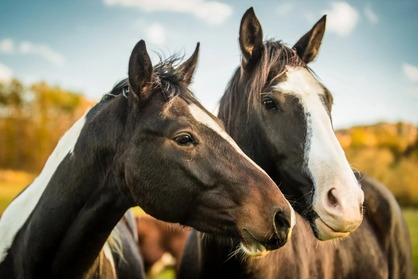
One ear cocked back. This is often indicative of a horse that is listening to something in another direction than out front or paying attention to what is being asked of him while maintaining alertness in the direction of travel. He might be saying: “I am listening to my rider.” “I am paying attention to something behind me.” “There is something that has my interest to the side of me.” “I am aware of things in both directions.”
Horses prick their ears when startled. Pricked ears could signal the horse is startled, vigilant, alert, or interested. It is not uncommon to see pricked ears during frontal greetings. But if he stays with his ears stiff, he is likely agitated. Approach a horse with its ear pricked cautiously.

Horses with their ears extended are relaxed. A horse may have his ears extended out with the openings facing downward to the ground. When horses extend their ears and let them fall toward the side, it’s usually a sign of a relaxed horse, but it could indicate he is tired or lacks interest in the world around him at the moment. Horses that extend their ears are comfortable.
Fully pinned ears are a sign of aggression. A horse pins his ears when he is threatened and or finds it necessary to exhibit anger, aggression, and dominance. He is getting ready for a fight or attack. Pinned ears refer to a horse flattening his ears back against his head, making them almost invisible. From the side, they are not seen. Flattened ears are the most aggressive signal a horse makes with his ears. It is an ancient “ear protection” posture used to protect the ears during a fight or attack. Pinned ears are a threat signal to other horses.
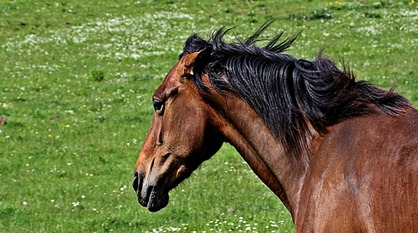
Pinned ears may also mean the horse is in pain. A horse may also move them restlessly back and forth if experiencing discomfort. Their ears may also droop out to the side, sometimes described as airplane ears, when depressed or in prolonged pain.
Ears turned back are an indication of fear. Turned-back ears are typically a posture indicative of a brutal owner. Sometimes when a horse is being ridden, you will notice that his ears are drooped and turned back with the openings toward the rider. This may indicate the horse is afraid of the rider. The lower posture of the ear suggests submission.
Ears turned back (not pinned) means the horse is listening to something from behind. If you are riding and his neck is tense, he may be unsure of what you are asking him to do. He may be deciding how to react to the stimuli and whether to run away or turn around and check out a sound or movement. Your horse might be saying: “How do I react?” “What is that behind me?” “I am unsure what you are asking.” “I am confused.” “I am nervous.”

Flickering ears are a sign of stress. When you notice your horse’s ears flickering, it signals stress or a heightened state of anxiety. Flickering ears typically precede stationary pricked ears when the fear turns to panic. Takes steps to calm a horse with flickering ears.
Listening back and forth. The horse is in a heightened state of alertness or anxiety. He may be trying to find the source of an unusual sound or smell or may feel overwhelmed, upset or anxious. He might be trying to say: “I don’t know what to make out of that strange sound.” “I am worried!” “What is that?” “How should I react?” “Fight or flight?” “How can I get away quickly?” “I may be on the verge of panic.”
Droopy ears are a sign your horse is tuning out. He could be exhausted and sleepy, or he may be suffering from pain. Drooping ears are when the ears extend down on either side of the head of the horse. It is a sign that he is trying to switch off the outside world. Droopy ears can also be a sign of inferiority in a herd situation. According to researchers, the distance between the bases of the ears increases during pain incidents (because the ears tended to drop slightly down to each side of the head with a concomitant outward rotation of the ears).

Drugged ears move in an unusual motion. Certain drugs are illegal to use in competitive horse events and can be detected by paying attention to the horse’s ears. Their ears will move in an unusual motion. The two most common drugs in use are varieties of stimulants or depressants.
Mobile ears are normal horse behavior. Horses are herd animals; one way they communicate with each other is through their ears. Mobile ears are the norm; horses will continuously shift the direction of their ears, picking up on new sounds.
Sources: Horses Ears: Positions and What They Mean is Revealed! (HorseRacingSense); Lend Me Your Ears: What Does Your Horse’s Ear Position Tell You (Horse Illustrated); Understanding Horse Body Language: Ears (Open Sanctuary)
39 notes
·
View notes
Text
"I was too caught off guard to know how to receive her. Our intimacy had been confined to hidden, lowly places like the barracks washroom. This was a breach, a rupture, something we couldn't even acknowledge. Outside the framework of our time as food tasters, our friendship lost its urgency. It confused me."
"Rosa Sauer" (At the Wolf's Table by Rosella Postorino)
#friendship#female friendship#at the wolfs table#rosa sauer#wwii#caught off guard#intimacy#rosella postorino#quote#writing#fiction writing
2 notes
·
View notes
Text

"Beautiful, sir." --Marcie
#writeblr#marcie#peppermint patty#writing tips#peanuts#writing advice#snoopy#writing#ice skating#they must be really good friends#charles m schulz#actual quote#marcie made the dress#technically#marcies mother made pattys dress
7 notes
·
View notes
Text
People Are Using A.I. to "Write" Unauthorized Books From Popular Authors and Sell Them on Amazon
Read the Article: "An author says AI is ‘writing’ unauthorized books being sold under her name on Amazon" by Clare Duffy, CNN (article appears in full, below)
Supplemental Reading: "I Would Rather See My Books Get Pirated Than This (Or: Why Goodreads and Amazon Are Becoming Dumpster Fires)" by Jane Friedman
❯ ❯ ❯

New York (CNN) -- An author is raising alarms this week after she found new books being sold on Amazon under her name — only she didn’t write them; they appear to have been generated by artificial intelligence.
Jane Friedman, who has authored multiple books and consulted about working in the writing and publishing industry, told CNN that an eagle-eyed reader looking for more of her work bought one of the fake titles on Amazon. The books had titles similar to the subjects she typically writes about, but the text read as if someone had used a generative AI model to imitate her style.
“When I started looking at these books, looking at the opening pages, looking at the bio, it was just obvious to me that it had been mostly, if not entirely, AI-generated … I have so much content available online for free, because I’ve been blogging forever, so it wouldn’t be hard to get an AI to mimic me,” Friedman said.
With AI tools like ChatGPT now able to rapidly and cheaply pump out huge volumes of convincing text, some writers and authors have raised alarms about losing work to the new technology. Others have said they don’t want their work being used to train AI models, which could then be used to imitate them.
“Generative AI is being used to replace writers — taking their work without permission, incorporating those works into the fabric of those AI models and then offering those AI models to the public, to other companies, to use to replace writers,” Mary Rasenberger, CEO of the nonprofit authors advocacy group the Authors Guild, told CNN. “So you can imagine writers are a little upset about that.”
Last month, US lawmakers met with members of creative industries, including the Authors Guild, to discuss the implications of artificial intelligence. In a Senate subcommittee hearing, Rasenberger called for the creation of legislation to protect writers from AI, including rules that would require AI companies to be transparent about how they train their models. More than 10,000 authors — including James Patterson, Roxane Gay and Margaret Atwood — also signed an open letter calling on AI industry leaders like Microsoft and ChatGPT-maker OpenAI to obtain consent from authors when using their work to train AI models, and to compensate them fairly when they do.
A Growing Problem
Friedman on Monday posted a well-read thread on X, formerly known as Twitter, and a blog post about the issue. Several authors responded saying they’d had similar experiences.
“People keep telling me they bought my newest book — that has my name on it but I didn’t write,” one author said in response.
Amazon removed the fake books being sold under Friedman’s name and said its policies prohibit such imitation.
“We have clear content guidelines governing which books can be listed for sale and promptly investigate any book when a concern is raised,” Amazon spokesperson Ashley Vanicek said in a statement, adding that the company accepts author feedback about potential issues. “We invest heavily to provide a trustworthy shopping experience and protect customers and authors from misuse of our service.”
Amazon also told Friedman that it is “investigating what happened with the handling of your claims to drive improvements to our processes,” according to an email viewed by CNN.
The fake books using Friedman’s name were also added to her profile on the literary social network Goodreads, and removed only after she publicized the issue.
“We have clear guidelines on which books are included on Goodreads and will quickly investigate when a concern is raised, removing books when we need to,” Goodreads spokesperson Suzanne Skyvara said in a statement to CNN.
Friedman said she worries that authors will be stuck playing whack-a-mole to identify AI generated fakes.
“What’s frightening is that this can happen to anyone with a name that has reputation, status, demand that someone sees a way to profit off of,” she said.
The Authors Guild has been working with Amazon since this past winter to address the issue of books written by AI, Rasenberger said.
She said the company has been responsive when the Authors Guild flags fake books on behalf of authors, but it can be a tricky issue to spot given that it’s possible for two legitimate authors to have the same name.
The group is also hoping AI companies will agree to allow authors to opt out of having their work used to train AI models — so it’s harder to create copycats — and to find ways to transparently label artificially generated text. And, she said, companies and publishers should continue investing in creative work made by humans, even if AI appears more convenient.
“Using AI to generate content is so easy, it’s so cheap, that I do worry there’s going to be this kind of downward competition to use AI to replace human creators,” she said. “And you will never get the same quality with AI as human creators.”
❯ ❯ ❯
Read the Article: "An author says AI is ‘writing’ unauthorized books being sold under her name on Amazon" by Clare Duffy, CNN
Supplemental Reading: "I Would Rather See My Books Get Pirated Than This (Or: Why Goodreads and Amazon Are Becoming Dumpster Fires)" by Jane Friedman
#writeblr#writing#writing tips#writing advice#novel writing#jane friedman#artificial intelligence#the problem with ai#fiction writing#book publishing#publishing#authors#generative ai#genai#the rise of ai#publishing research#reporting#clare duffy#goodreads and amazon are becoming dumpster fires#cnn#writing help#writing tools#writer tips
2 notes
·
View notes
Text

#original photography#lensblr#architecture#building design#brick building#campus#greek#original photographers
1 note
·
View note
Text

#early morning#sunrise#photography#lensblr#original photographers#original photography#palms#partly cloudy#colors of the sky#orange sky#nature photography#atmos
10 notes
·
View notes
Text
“Blood and death is a price we women pay every day. Why not those who deserve it? We have reclaimed our destinies and are helpless creatures no more. Perhaps murder is not your idea of a respectable profession, but we do the work as we find it.”
— The Crimson Queen (Kingdom of the Blazing Phoenix by Julie C. Dao)
#writeblr#ya fiction#writers of color#asian fantasy#julie c dao#folktale#crimson queen#womens rights#mercenary#kingdom of the blazing phoenix#band of female warriors#quote#philomel books#princess jade
1 note
·
View note
Text

#sunrise#early morning#photography#lensblr#atmos#clouds#orange#sunrise over the supermarket#original photography#photographers on tumblr#original photographers
11 notes
·
View notes
Text
Fantasy Worldbuilding Questions (Governance)
Governance Worldbuilding Questions:
What forms of governance exist (do they differ by region)? For example, monarchy, democracy, tyranny, oligarchy, anarchy.
What is the biggest threat to stable government in your world?
Who is the most loved leadership figure (or the most hated and feared) and why?
Who governs key parts of your world (e.g., this may be the pilot of a spaceship in a sci-fi story)? Will the head honcho change?
Where are the major centers of power and administration in your world, and why are they located in these places?
Where are laws and policies enforced the most, and where is the long arm of the law weakest?
When were the laws that most affect your characters passed? Are there any troubling ones on the ballots?
When did this world’s current system of government or political system come into existence, and what were the historical and cultural factors that led to its formation?
Why do characters either support or resist the government? In what ways it is benevolent or abusive?
Why do individuals or groups hold power to govern? Is it a birth right system, an electoral one, or the result of a coup or other event?
❯ ❯ ❯ Read other writing masterposts in this series: Worldbuilding Questions for Deeper Settings
#writeblr#fiction writing#novel writing#writing tips#writing advice#writing#worldbuilding#writing research#fantasy fiction#fantasy writing#now novel#governance#fwq
53 notes
·
View notes
Text
Comics Review: Trapped on Zarkass
Trapped on Zarkass by Yann, Didier Cassegrain
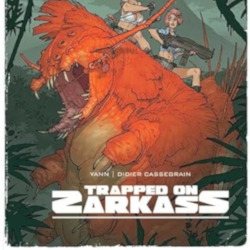
action
offworld
scifi
terraforming
My Rating: 4 of 5 stars
Marcel Dorcel is a convicted criminal with three exes, a mind that's keen on identifying political subterfuge, and enough experience surviving the wilds of Zarkass that she makes for the best (worst) tour guide one could hope for. In her own words, "just because I'm ballsy doesn't mean I'm stupid." But then again, if one were not relying on Marcel to ford the wilds during the apparent crumbling of the local human outpost, then who?
TRAPPED ON ZARKASS is exquisitely colorful and richly indecent, what with its focus on an odd-couple pair who is absolutely terrible at doing precisely whatever it is they're supposed to be doing. Marcel is the guide and bodyguard; Louis Doisy is an entomologist sent undercover from the local human government. Louis is supposed to be investigating the wreckage of an unnamed adversary's ship, but as often happens in sci-fi exploits, the woman has her own agenda at hand. En totem, navigating jungle flora, all the while surviving encounters with giant spiders, carnivorous butterflies, and hostile populations of roach-people puts this duo on high alert from cover to cover.
One imagines the task of surviving a mysterious planet of hostile others would be equally exciting and terrifying, and TRAPPED ON ZARKASS delivers on both accounts. Is tracking down and investigating an intergalactic crash site on a wayward Earth colony worth the effort? After dropping into the luscious greenery, all bets are off.
Not to say the story makes it easy for these characters to have a good time. Marcel is crass and butch and doesn't really give a shit, but she's a felon who can't quit digging a deeper grave for herself. If she and her partner can pull off this mission, then she'll sleep in a real bed for the first time in 20 years. Louis is snotty and upper-class, but her ambition tends to outweigh any sense of danger lurking over the next cliff. A person with a secret agenda and with nothing to lose tends to harbor the most gall. Marcel and Louis hate each other from the outset, but if they're going to survive the bush and make it back to civilization before everything turns to crap, then they must swallow the irritation they have for one another, one thorny affront at a time.
TRAPPED ON ZARKASS is a beautiful book and demonstrates the best character art many contemporary European comics have to offer: angular but dimensional character designs that don't take up more space than they need to; brilliant and moody coloring; environmental designs and background artwork with layers of informational detail; compelling character expressions that never give away too much. Cassegrain has a style that offers comfort and order on one level (e.g., balanced page composition, smart character blocking) and desirable anarchy on another (e.g., designing messy and dangerous slums, ruins, battle sequences, caverns).
One finds it difficult to disassociate the comic's superlative design quality from its narrative spectacle. For example, it's one thing for readers to come across a lying and scheming indigenous queen and her chosen warrior, but it's another thing entirely to see the warrior stride into frame while mounting a massive cicada and wielding a war axe. It's one thing for readers to learn the local roach-people use the mucus of large lion-caterpillars to protect their skin, but it's another thing entirely to see the locals grieve the loss of their partner-beasts, then throw themselves to their death, glimpsing the emerald splendor of this far away planet for a final, sharp, and fleeting moment.
The book's flaws are niggling but not imperceptible. Notably, Marcel's attitude vacillates unpredictably between caustic foolery and optimistic thuggery. The woman knows more about the planet Zarkass and its dangers than anyone around, but constantly berates the locals and draws ire from her allies. Her insults are hilarious (e.g., "snotty vagsack," "holy ovum," "deadballs," "bloody vulva"), but the butch woman's intense love-hate relationship with the universe makes for seesaw storytelling. As for Louis, the woman is a good foil, but her apparent knack for having helpful visions of next-step adventuring feels too contrived to be effective. Louis is funny because she's absolutely the last person one would want to rough it with in the bush; but perhaps that's the point. Nevertheless, TRAPPED ON ZARKASS wrings from its pages a tale of otherworldly sci-fi in which suspiciously opportunistic people from very odd, awkward, and asynchronous points of origin strive for survival.
❯ ❯ Comics Reviews || ahb writes on Good Reads
#review#comics reviews#trapped on zarkass#didier cassegrain#yann#comix buro#magnetic press#butch woman#planet zarkass#offworld#4 of 5 stars#scifi comics#terraforming#zinn#louis doisy#marcel dorcel#mysterious planet#lying and scheming#goodreads
0 notes
Text
Glasses stuff. More people should know about this.
Gothic fiction sunglasses secrets
I used to collect vintage sunglasses for my own amusement. They got pretty badly scratched up during a move so I lost some interest in the serious collecting however my knowledge of the trivia surrounding vintage sunglasses might be of use to some people. Particularly role players, fain fiction writers, and history buffs.
Let’s discuss my favorite sunglasses. The Victorian era sunglasses. In the Victorian era there was a bit of an optometry pseudo-science that was semi-correct in some regards that certain colors of sunglass wear served particular purposes of usefulness in treating various ailments or masking the symptoms of said ailments.
Here we have Gary Oldman as Dracula bearing a pair of stylish pince-nez sunglasses.

Pince Nez Sunglasses are not teashades (Lennon Specks). More on that later.
Pince Nez Sunglasses have no arms and are usually held in place by a spring mechanism at the nose bridge or with nose guards that pinch at the bridge of the nose. One drawback is that if you wear them for long periods of time they can leave temporary red marks there.
In the Victorian era it was believed that various colored glasses could be used to treat certain ailments, physical and psychological.
For example: Here we have cobalt and it was believed that cobalt could aid with physical photosensitivity / Photophobia (Light sensitivity). A very accurate pair of sunglasses for a nocturnal predator to be wearing, not merely for being stylish. Cobalt lenses were often prescribed by a doctor. Let’s not question where Dracula found a doctor and what he did with said doctor.
And here we have Dracula / Alucard from Hellsing in his actual round Teashades / Lennon specks / Ozzy Specks (as they are sometimes called now).
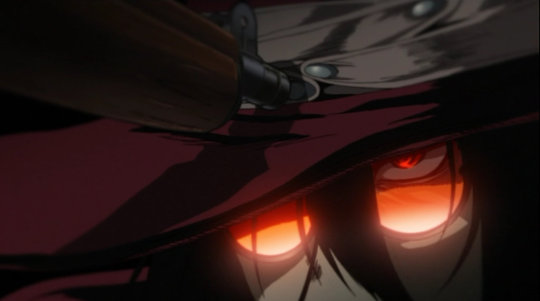
This anime is very stylized and the manga is usually black and white (save for the cover art) so let’s pretend they are red glasses.
You will notice in the original Hellsing anime the teashade (Lennon Specks) sunglasses that Alucard / Dracula wears have distinct side eye guards / light guards. This is to prevent light and wind from interfering with vision, particularly in fast motion. They cause his glasses to resemble old fashioned biker goggles (Late Victorian / early twentieth century style) riding goggles / driving goggles but when fitted onto sunglasses like these the side light guards are often called “Mountain style.”

Note: Alucard’s sunglasses likely have the Victorian era ear holding arms. That means the ends of the sunglass arms actually curve around the earlobes and don’t just rest on the ears.
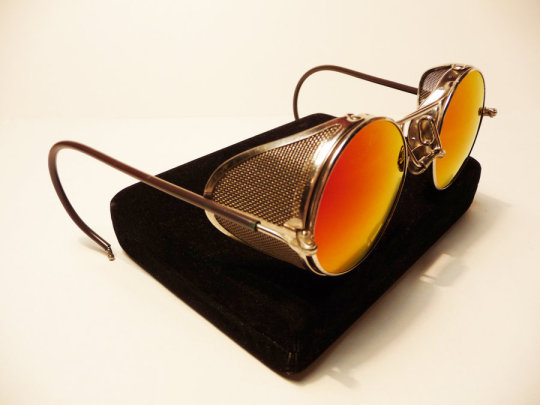
These sort of sunglass arms were popular in the nineteenth century and indicate that the sunglasses Alucard wears in Hellsing are legitimate antiques if not exact replicas of a Victorian pair, perhaps modeled after Abraham Van Helsing’s own spectacles as Alucard also wears a similar duster to him.
It’s believed that red in sunglasses are good for depth perception- allowing you to tell where an object ends and a shadow begins far easier and how deep shadows run and how steep things are in a much easier way than what nature allows, especially where colors may seem to blend. Naturally this would likely enhance a creature that already has night vision, perhaps slightly improving already highly keen nocturnal eyes, giving the wearier a decided edge over other similar beings.
This might explain why Dracula / Alucard in Hellsing wears the red Lennon specks and why Blade sports a pair of sleek, red, modern Riding sunglasses loosely modeled after semi-oval biker goggles here in the Blade anime.
Red is also supposed to help provoke and stimulate hunter instincts and aggression in most mammalian predators.
The lesson here: No vampire should trust another vampire wearing red lensed sunglasses. Red lenses = Vampire Killer… maybe.
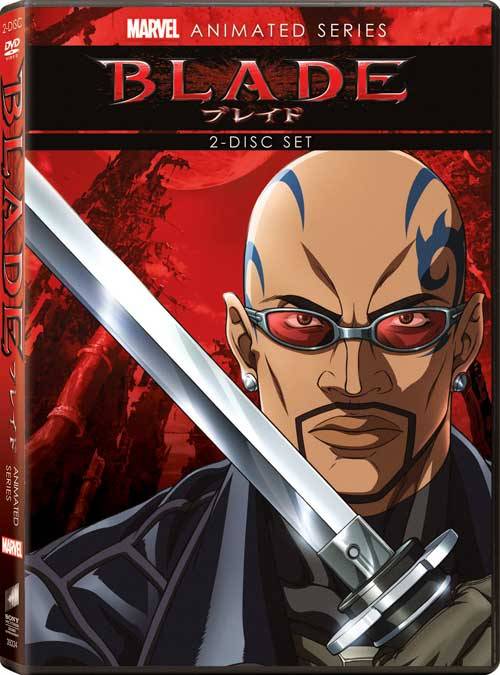
Rose colored glasses are supposed to induce positive feelings and reduce negativity. It was once believed that pink or rose tinted glass could help fight depression and anxiety and render you calm, relaxed, mellow, and positive. “She’s looking at the world through rose colored glasses.”
Purple is supposed to help with light sensitivity, help induce positive feelings, and also improve contrast for depth perception. The main draw back with purples and blues are they can trick the brain into thinking it’s later than it is as they tend to resemble dusk or dawn. This can induce the body to prepare for rest or trick the eyes into adjusting for night time darkness that isn’t actually coming.
Teashades (which in more recent years gained the name Lennon Specks and Ozzy Specks - Specks being short for spectacles) were popularly used by gentlemen in the Victorian era while having outdoor tea in the glaring afternoon sunlight or walking to a friend’s home for tea to reduce the harshness of daylight. The less innocent purpose for these sunglasses were to hide the effect of opium. Brown (particularly dark brown) was best for hiding bloodshot eyes. In the 1960s and 1970s these sort of sunglasses were again used to hide the effects of opiates and narcotics. As younger people used the sunglasses to hide the effects of marijuana in the modern world, back in the Victorian era it would not be surprising to see a man wear these sunglasses when leaving an opium den.
And here are Thomas Sharpe and his sister from Crimson Peak wearing those sort of sunglasses.
It’s hard to tell what color these are but they might actually distribute light as grey tinted. Grey is supposed to be good for driving and for helping to retain alertness whereas cobalt can trick your subconscious into thinking it’s dawn or dusk and also trigger melatonin production in the brain by deceiving the internal clock into thinking that it is truly later than it actually is.

Grey, brown, or yellow sunglasses are supposed to be good for winter weather because they help prevent “snow blindness” and shield against the sunlight bouncing off of the highly reflective snow while also retaining most natural color perceptions. This may account for the particular sunglasses Thomas Sharpe wears in Crimson Peak since they often get heavy snows and he would appreciate the color contrasts for being able to see where the red clay is “Bleeding” through the snow.
It is very likely that Dracula / Alucard in Hellsing wears the teashades in honor of Abraham Van Helsing who wore round framed spectacles and a dark duster jacket similar to the red one Alucard Wears in Hellsing. Integra also wears the round spectacles that may have helped inspire Alucard’s sunglassses frames of choice.
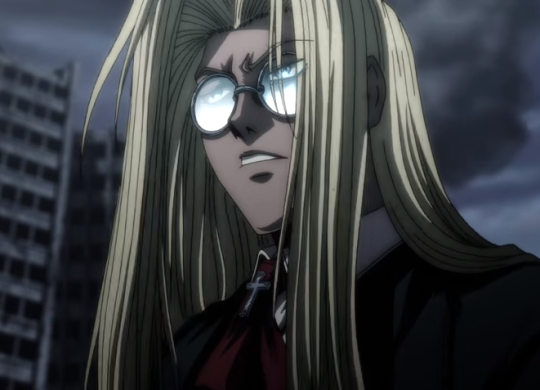
Here we have Johnny Depp as Barnabas Collins in the Tim Burton movie version of Dark Shadows (based on the 1960s and early 1970s TV series of the same name) wearing Mountain Style Horizontal half-moon framed sunglasses with the the blue cobalt for light sensitivity. Mountain style just means it has the “Steam punk” side light guards (Size and shape of which vary). These sunglasses are actually larger than the original Victorian ones they are modeled after.
Note: Barnabas is NOT a character of the Victorian era. The Victorian era entails the mid nineteenth century until roughly 1901. Queen Victoria was not alive in the seventeen hundreds, which is when Barnabas became a vampire.

Here we have the original 1970s Blade as depicted in marvel comics wearing Green sunglasses. These style of sunglasses are called Raceday sunglasses.
Yellow and orange lenses were supposed to help against Insomnia and also liver conditions like jaundice. Whether it was believed they would actually help or just distract from the yellowing of the skin is anyone’s guess.
Green however had a simpler use. Green distributes color evenly so that color is not distorted despite you’re wearing. Theoretically you can still distinguish colors as nature intended.
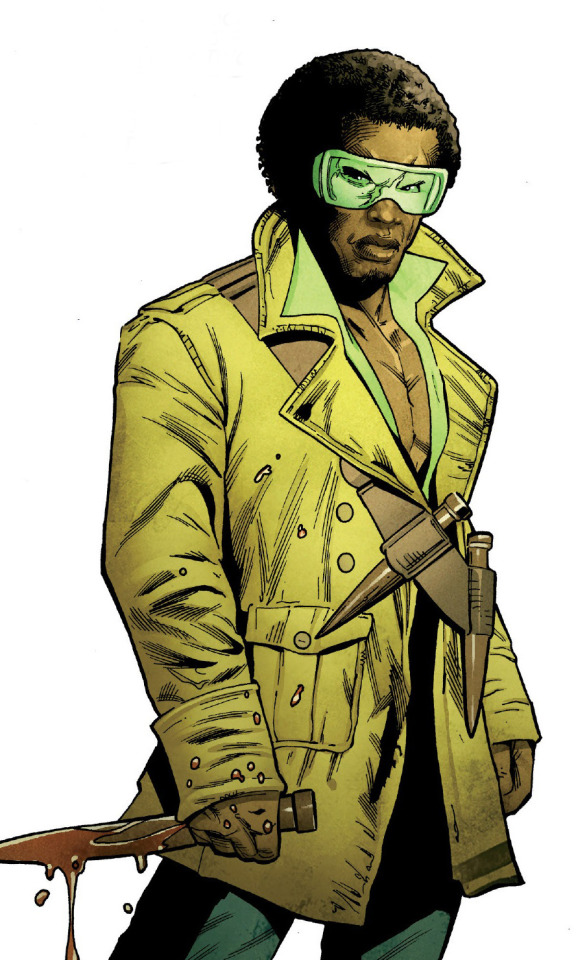
_________________________________
Old beliefs about sunglasses colors:
Disclaimer: I do not necessarily agree with anything said below about the purpose, uses or drawbacks of particular sunglasses colors. This is subjective, personal, varies from person to person and is based on mostly debunked old beliefs and pseudo-science. Try not to take it too seriously. Wear whatever you are comfortable with and don’t let any peculiar old beliefs taint that for you.
Green: = Retains natural color spectrum so you can still differentiate color while getting some light protection. Supposed to promote growth and possible allergy resistance… for some reason. They are also supposed to help improve intellectual stimulation, curiosity and a connection to nature.
Drawbacks: Many greens are very light and though often offer considerable UV protection they may not seem dark enough for those who are light sensitive. Green sunglasses are also the victim of the myth that darker lenses are better protection from UV rays. The truth is that darker lenses don’t always mean better UV protection and sometimes the lighter glasses might be better for such protection.
Yellow and light orange: = Helps stave off insomnia and is supposed to help with liver conditions and jaundice. These are good for winter weather and can prevent snow blindness. In modern times yellow, light brown and certain orange tinted sunglasses are often used for computer reading glasses, often magnifying besides being believed to be able to defuse some of the excessive brightness of computer screens, preventing eyestrain when looking at brightly lit monitors for extended periods of time.
Drawbacks: If you are not used to yellow or orange computer reading glasses then when you take them off colors might temporarily seem strange as your eyes had adjusted to functioning behind the yellow tinted glass. It can be a surreal experience.
Blue or cobalt: = Often prescribed for illness related light sensitivity in the late Victorian era. As those with photophobia / Photosensitivity tended to be nocturnal cobalt was believed to gently deceive the wearer’s nocturnal inclinations into behaving as if it is early evening instead of mid-day while providing much needed protection against the harsh mid-day light.
Drawbacks: The main drawback (as it is currently believed) is that cobalt can trick the brain into thinking it is dusk or dawn and interfere with sleep patterns or trick the eyes into not adjusting enough for shifts in natural light and might not be actually protecting against the brightness. This means when the glasses come off it’s not a gentle transition if you are still in harsh, bright light. And it may slow down eye dilation. The eyes behind the glass respond as if light is dim and aren’t providing the natural protection against UV ray that simple acts like squinting can provide. Always make sure they have actual UV protection because despite being gentle on light sensitive eyes they could be doing more harm than good. This is why you won’t find many pharmacies or souvenir stands selling cobalt, violent / purple, or indigo colored sunglasses anymore.
Red: = Red is supposed to help improve depth perception allowing a sharper contrast between where blended shadow and substance are located, and being able to see the size and shape of objects that might otherwise blend with natural shadow or similar colors. Red is also supposed to stimulate aggression and primal energy in natural predators and could help improve alertness. Instincts might associate the colors of red and certain shades of orange with fire and blood which increase energy and could provoke the senses to heighten. It may be believed that red could improve assertiveness and help deter timidness. Depending on how you perceive the particular shade of red, you could instead have the same result as rose colored glasses, which is supposed to be somewhat calming.
Drawbacks: Though many red sunglasses provide legitimate UV protection the color could deceive the wearer into actually thinking it’s brighter outside than it actually is rather than gently dimming the perceived light. Unlike rose colored glasses which are supposed to induce calm, positivity and by extension passivity, actual red or orange-red lenses could theoretically bring about tension and defensiveness unless the wearier associates such tints with gentle sunsets. This can be subjective from person to person and for some people the red or red-orange lenses might bring about the opposite of the believed result and instead they would have the same effect as rose colored glasses. Everyone is different. This means you could end up with the opposite effect of what is intended. But for many it is thought that to reduce stress and social anxiety a purple or rose tint might be better.
Grey: = Grey lenses are supposed to be good for driving or other rapid motions such as biking, horseback riding, skiing, ect… Grey is supposed to help to retain alertness without triggering unnecessary aggression (as red is supposed to sometimes do) while also defusing light. It was once believed that grey sunglasses could help prevent fatigue when driving for long stretches of time. It was believed that grey might also improve concentration, which is why for decades grey has been the usual choice for sunglasses for sports and outdoor activity enthusiasts. Green is also good for a similar purpose because it helps retain the natural sense of the color spectrum. This also includes sunglasses that appear black or mirrored from a distance but seem grey when actually gazed through them.
Grey, brown, or yellow sunglasses (and some others) are supposed to be good for winter weather because they help prevent “snow blindness” and shield against the sunlight bouncing off of the highly reflective snow while also retaining most natural color perceptions.
Drawbacks: Some believed that grey tinted glasses could actually induce insomnia while yellow sunglasses could fight insomnia. So if you are not trying to stay awake or if you already suffer from insomnia these sunglasses may not be a good choice for you.
Brown: = Brown is supposed to be good for hiding blood shot eyes and the effects of narcotics like opium. Brown is supposed to also help reduce headaches and calm the senses. It is supposed to be a good color to stave off nausea and promote health.
Drawbacks: The drawback of the brown sunglasses is the social stigma that as early as the Victorian era in England brown sunglasses were sometimes (not always) associated with opium addicts and drunkards trying to hide their bloodshot eyes. It was impolite to question a man wearing brown teashades about if he was just trying to protect against sunlight or deliberately hiding his eyes and many people loved to gossip about one who might be hung over.
Other than the social stigma the only other drawback of brown sunglasses is the same stigma you see with all darkly tinted sunglasses, that despite the dark tint the glasses might not necessarily be protecting the eyes enough from UV light (always check). The problem could be that the eyes will behave as if it is dark out and the dilation will respond accordingly, reducing natural protection against harmful and excessive UV light. Darker sunglasses does not necessarily mean better UV protection. Always check to be certain. This is true with any color of sunglasses. You could accidentally end up damaging your eyes if you do not have enough UV protection, especially if the glasses you wear are dark but are not offering enough UV protection because it reduces the natural protection you give yourself by simple acts like squinting and the change in pupil dilation.
Rose: = Pink, certain shades of purple or rose colored glasses very literally are supposed to help ward off negativity in thoughts and perceptions of the world around you, improving optimism and fighting depression while reducing stress, anxiety, and pessimism. They were believed to lower aggression and increase passivity. Modern hippies (1960s and early 1970s) thought that wearing rose colored glasses could defuse anger or violent tendencies.
Drawbacks: The drawbacks of rose colored glasses are similar to those of blue or cobalt colored glasses. There is also the semi-superstition belief that looking at the world through such glasses could literally prevent you from noticing or acknowledging stressful problems or negative situations that need to be faced directly.
Note: As everyone perceives certain colors differently you could have an adverse reaction to the intended result and end up with a reaction similar to what many have toward red or certain red-orange colors. It varies from person to person.
Note: My personal least favorite sunglasses are all variations of Aviator sunglasses or Aviator teardrop sunglasses. I find them ugly. That is just my personal opinion. They have been annoyingly popular since the 1980s and I do not like them.
#writeblr#glasses#writing advice#writing#writing community#writing tips#novel writing#Dracula#Gary Oldman#Blade#Hellsing#Alucard#count dracula#Vampire#Victorian#Vampires#Bram Stoker#Tom Hiddleston#Gothic Fiction#Gothic Literature#photosensitivity#fiction writing
47 notes
·
View notes
Text

#photography#original photography#trees#bare trees#nature photography#branch architecture#blue sky#lensblr
2 notes
·
View notes
Text
"Social realities are constructs. People mistakenly believe social institutions and structures to be natural realities because the regimes striving to construct legitimacy for these social systems present them as unchangeable and sacred."
Abdullah Öcalan (author, Manifesto for a Democratic Civilization, 2015)
#capitalism#modernism#cultural legitimacy#abdullah ocalan#writeblr#quote#writing#novel writing#fiction writing#writing tips#writing advice
3 notes
·
View notes